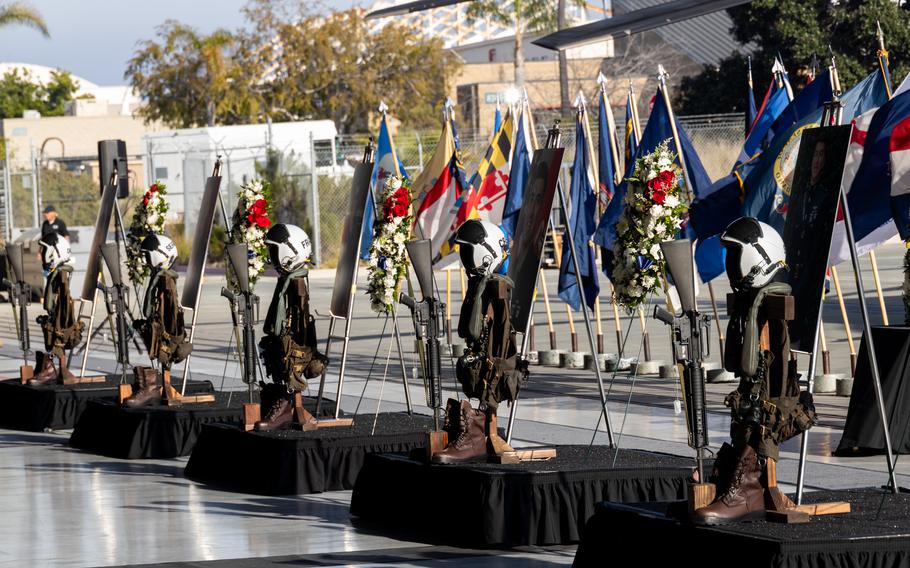
Five battlefield crosses are displayed in honor of five Marines of Marine Heavy Helicopter Squadron 361, Marine Aircraft Group 16, 3rd Marine Aircraft Wing, during a memorial ceremony at Marine Corps Air Station Miramar, Calif., in February 2024. The Marines were killed in a helicopter crash. (U.S. Marine Corps photo)
WASHINGTON — A fatal Marine Corps helicopter crash last year was caused by pilot error, but deteriorating weather conditions and the use of night vision goggles might have been contributing factors, according to an investigation released Wednesday.
Three pilots and two crew chiefs were aboard the CH-53 Super Stallion that crashed Feb. 6, 2024, during a late-night flight when the aircraft hit a mountain near Pine Valley, Calif., on its way back to Marine Corps Air Station Miramar. The helicopter was discovered the next morning. All five Marines aboard were killed in the crash.
The helicopter, “TIGER 43,” was assigned to Marine Heavy Helicopter Squadron 361, Marine Aircraft Group 16 of the 3rd Marine Aircraft Wing. The crew was returning to the base from Creech Air Force Base, Nev., when the helicopter crashed.
The investigating officer ultimately found the pilot failed to avoid the mountainous terrain likely due to poor visibility.
During the nighttime flight, there was moderate icing and cloud layers along the helicopter’s route that might have prevented a safe flight. The crew was also using night-vision goggles, which likely did not give them the clear view needed to avoid crashing into the terrain, investigators found.
The limits of night-vision goggles also have been identified as a potential factor in the fatal collision of an Army Black Hawk helicopter and a passenger jet near Reagan Washington National Airport in January that killed 67 people. The goggles can reduce a pilot’s ability to determine distance and can be degraded by weather or light pollution.
“We may never know the exact reason for this root cause, and the [investigating officer] cannot pinpoint one explanation,” the report reads.
While not a contributing or casual factor, the investigation also found the commanding officer of the Miramar-based squadron should not have approved the crew to fly.
Nine months after the crash, Lt. Col. Nicholas Harvey, the commanding officer, was relieved of duty “due to a loss of trust and confidence in his ability to continue to serve in that position,” according to a statement provided by the service in November.
“The commanding general determined that [Harvey] exhibited poor judgment and was expected to exercise greater care in the performance of his duties,” said the 3rd Marine Aircraft Wing, which oversees West Coast-based squadrons.
In interviews contained in the report, multiple members of the squadron said crews had been stretched thin because their unit had to fly additional missions to compensate for last year’s monthslong grounding of the V-22 Osprey fleet.
Three days after the crash, the service announced five Marines were killed in the crash — Capt. Benjamin Moulton, Capt. Jack Casey, Capt. Miguel Nava, Lance Cpl. Donovan Davis and Sgt. Alec Langen. On Feb. 16, 2024, the squadron held a memorial ceremony in which more than 550 people gathered to pay tribute to the loss of the crew.
Moulton, 27, was a CH-53E helicopter pilot from Emmett, Idaho. He was commissioned in March 2019 and promoted to captain in August 2023, according to the Marines. His decorations include the National Defense Service Medal.
Casey, 26, was a CH-53E helicopter pilot from Dover, N.H. He was commissioned in May 2019 and promoted to captain in September 2023, according to the service. His decorations include the National Defense Service Medal.
Nava, 28, was a CH-53E helicopter pilot from Traverse City, Mich. He was the longest tenured of the five fallen Marines. He was commissioned in May 2017 and promoted to captain in November 2021. His decorations include the Global War on Terrorism Service Medal, National Defense Service Medal and Sea Service Deployment Ribbon, according to the service.
Davis, 21, was a CH-53E helicopter crew chief from Olathe, Kan. He enlisted in the Marines in September 2019 and was promoted to lance corporal, the service said. His decorations include the Global War on Terrorism Service Medal, National Defense Service Medal and a Sea Service Deployment Ribbon.
Langen, 23, was a CH-53E helicopter crew chief from Chandler, Ariz. He enlisted in the Marine Corps in September 2017 and was promoted to sergeant in October 2022, the service said. His decorations include the Navy and Marine Corps Achievement Medal, Good Conduct Medal, Global War on Terrorism Service Medal, National Defense Service Medal and two Sea Service Deployment Ribbons.
“We will never forget the Marines of TIGER 43,” the 3rd Marine Aircraft Wing said.
Stars and Stripes reporter Gary Warner, and The Associated Press contributed to this report.